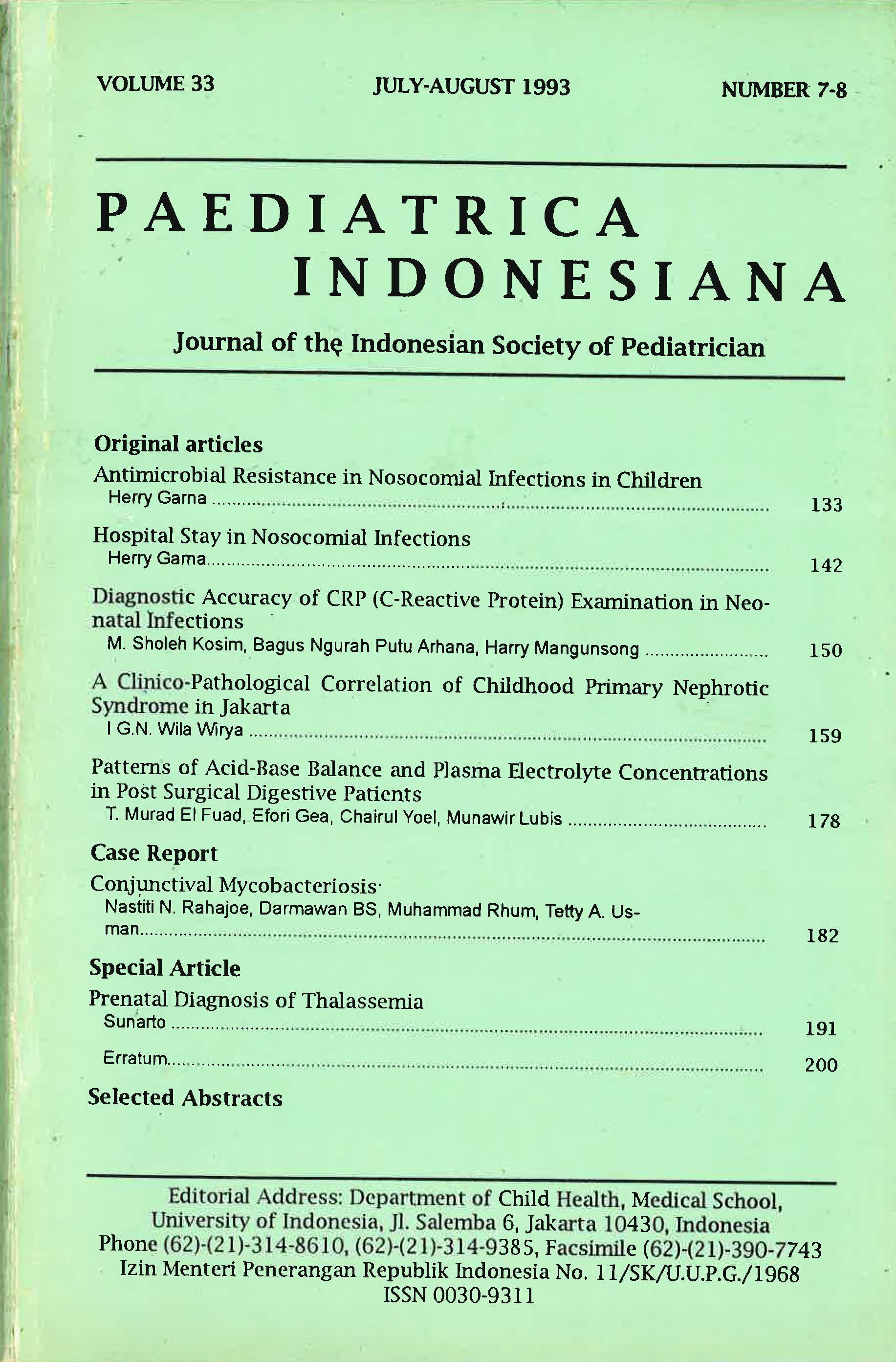Antimicrobial Resistance of Nosocomial Infections in Children
Abstract
A 9 month prospective study , from August 1988 to April 1989, was performed at the Department of Child Health, Medical School, Padjadjaran University, Hasan Sadikin Hospital Bandung. The aim of the study was to identify the pattern of sensitivity of bacteria causing nosocomial infections. It was revealed that among 4328 hospitalized pediatric patients, a total number of 342 patients had one or more nosocomial infections, yielding 411 episodes. Twenty-five per cent of isolated S. aureus was resistant to either ampicillin or oxacyllin. Higher percentages of resistance were observed in S. albus, i.e., to penicillin (53.3%) and oxacyllin (46.7%), and to cefuroxime, erythromycin and clindamycin (each in 40.0% of isolate). E. coli was In 86.3% resistant-to ampicillin, 78.4% to chloramphenicol (and thiamphenicol), 56.8% to tobramycin and 48.2% to gentamicin. The isolated Salmonella sp was almost 100% resistant to ampicillin and chloramphenicol (and thiamphenicol) but was highly sensitive to amikacin, cefotaxime and netilmicin, arround 100%. Pseudomonas sp was 92.9% resistant to ampicillin, 85.7% to chloramphenicol (and thiamphenicol) and 78.6% to cefuroxime; on the contrary it was 92.9% sensitive to amikacin. It can be concluded that gram-negative microorganisms were in general showed highly resistant to ampicillin, chloramphenicol (and thiamphenicol), tobramycin, and gentamicin; on the other hand more than 90% were sensitive to netilmicin, cefotaxime and amikacin.
References
2. Weinsstein RA, Kabins SA. Strategies for prevention and control of multiple drug-resistant nosocomial infection. Am J Med 1981; 70:449- 54.
3. Parry MF. Epidemiology and mechanisms of antimicrobial reslsta.nce. Aro J Infect Contr 1989; 17:286-94.
4. Hughes JM. Nosocomial infection surveillance in the United States: Historical perspective. Infect Contr 1987; 8:450-3.
5. Williams RJ. Epidemiology of antibiotic resistance in gram-negative bacteria. J Hosp Infect 1988; 11 (Supp A):130-4.
6. Garcia DC, Trevis AR, Botto L, CeiVetto M, Sarubbi MA, Zorzopulos J. An outbreak of multiply resistant Pseudomonas aeruginosa in a neonatal unit: plasmid pattern analysis. J Hosp Infect 1989; 14:99-105.
7. Morgan Mei, Hart CA, Cooke RWI. Klebsiella infection in neonatal intensive care unit: Role of bacteriological surveillance. J. Hosp Infect 1984; 5: 377-85.
8. Farrar WE. Antibiotic resistance in developing countries. J. Infect Dis 1985; 152: 1103-8.
9. Janas, Sutoto, Punjabi NH. Infeksi nosocomial saluran cerna (INSC) pada penderita anak di Rumah Sakit Karantina, Jakarta. Kumpulan makalah pertemuan ilmiah berkala IV, BKGAI, Palembang. 1984: 385-98.
10. Murray BE, Alvarado T, Kim KH, et al. Increasing resistance to trimethoptrim-sulfamethoxazole among isolates of Escherichia coli in developing countries. J Infect Dis 1985; 152: 1107-13.
11. Neu HC. Antimicrobial agents: The old and the new. Am J Infect Contr. 1989; 17: 276-85.
12. Ryan JL. Antimicrobial use in hospital-acquired infections. Am J Infect Contr. 1989; 17: 311-5.
Copyright (c) 2019 Herry Garna

This work is licensed under a Creative Commons Attribution-NonCommercial-ShareAlike 4.0 International License.
Authors who publish with this journal agree to the following terms:
Authors retain copyright and grant the journal right of first publication with the work simultaneously licensed under a Creative Commons Attribution License that allows others to share the work with an acknowledgement of the work's authorship and initial publication in this journal.
Authors are able to enter into separate, additional contractual arrangements for the non-exclusive distribution of the journal's published version of the work (e.g., post it to an institutional repository or publish it in a book), with an acknowledgement of its initial publication in this journal.
Published 2019-01-24













